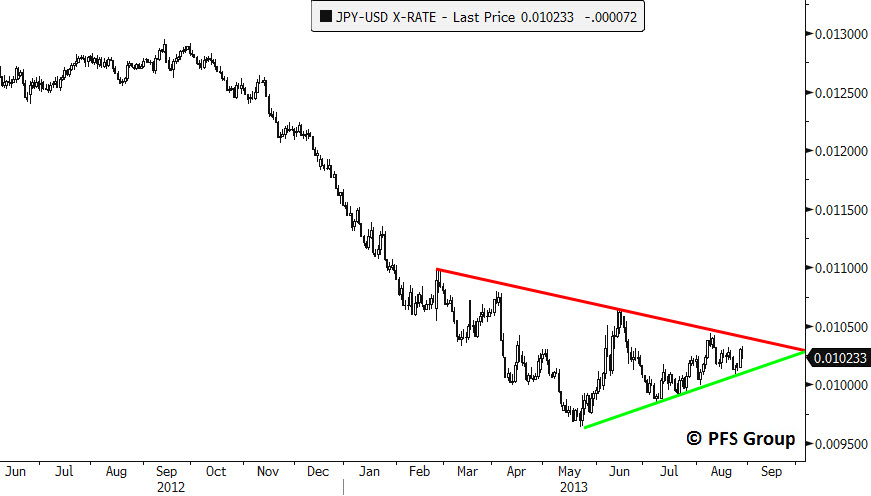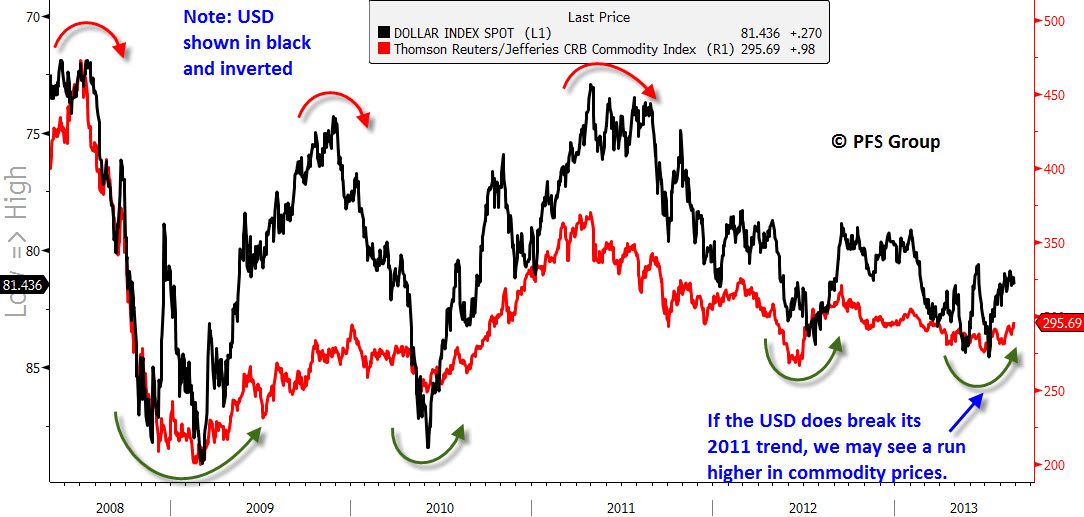Since 2011 there has been many persistent investment themes that have more or less been related to currency movements. However, we appear to be at yet another inflection point in which the trends that have been in place for more than two years will either continue or possibly reverse.
Perhaps the biggest investment trend since 2011 has been the strength in the USD Index, which can be seen in the chart below with a clear bullish trend for two years now.
There have been a number of factors helping to drive the bullish trend in the dollar: outperformance of US stocks over the rest of the world, outperformance by small cap stocks who derive more of their revenues domestically versus larger cap stocks who have significant foreign revenue exposure, weak commodity prices and weak performance in commodity-sensitive currencies. However, as seen in the chart above, we are testing the trend line that has been in place over these last two years and we will either see a rally with the aforemented trends remaining in place, or we could see the USD breakdown with a reversion of the trends that we’ve become accustomed to these past two years.
Another major point to keep in mind: the USD Index is dominated by a 57.6% weight against the Euro with the Euro/USD exchange rate. The Euro has been in a bearish trend relative to the USD since 2011 and is testing that bearish trend currently. If the Euro breaks out that would tend to suggest the European economic region seeing greater economic growth than the US, in which larger blue chip stocks in the US with exposure to Europe would likely become market leaders ahead.
Another currency that appears to be at an inflection point is the Japanese Yen. The Yen weakened considerably relative to the USD under “Abenomics” since last fall but has seen stabilization since May. We don’t know if this is a pause before a further decline or a possible trend change, which would be negative for Japanese stocks (Nikkei 225 Index) though bullish for gold and gold stocks.
Another significant change that would occur if the USD begins to roll over would likely be a rally in commodities. The CRB Commodity Index (shown in red below) moves inversely with the USD (shown in black and inverted) and has been in a bear market since 2011. We are seeing some stabilization in commodities this summer, which may be discounting further USD weakness ahead.
Summary
The biggest capital market in the world is the currency market, which trumps the bond market, which trumps the stock market in terms of capital flows. It is due to the size and importance of the currency markets that one should always keep a keen eye on currency trends as they tend to dominate the investment landscape.
The most dominant theme over the last two years has been a bull market in the USD, which has depressed commodity prices, led to outperformance by US stocks over global equities, as well as smaller cap companies who derive less revenue from overseas than their larger counterparts. Since the USD currently rests at key trendline support, further weakness may signal that the dominant investment themes that have been in place over the last two years may be about to change. For this reason, keep a close eye on the dollar in the coming weeks as well as the Euro and Yen.










